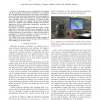1965 search results - page 297 / 393 » On the analysis of interacting pushdown systems |
IROS
2009
IEEE
14 years 3 months ago
2009
IEEE
— In this paper, a new tool dedicated to the analysis and the conception of molecules is presented. It is composed of an adaptive simulation software and a haptic device used to ...
MHCI
2009
Springer
14 years 3 months ago
2009
Springer
This paper summarizes value analysis of adopting technologysupported attendance control service in a primary school. The results are based on a case study that explored a 14-week ...
ICRA
2008
IEEE
14 years 3 months ago
2008
IEEE
— How to teach actions to a robot as well as how a robot learns actions is an important issue to be discussed in designing robot learning systems. Inspired by human parentinfant ...
HICSS
2007
IEEE
14 years 3 months ago
2007
IEEE
We studied 52 field examples interaction breakdown in information technology project virtual teams and actions leaders took to fix it using information and communication technolog...
ATAL
2007
Springer
14 years 3 months ago
2007
Springer
Agents engaged in noncooperative interaction may seek to achieve a Nash equilibrium; this requires that agents be aware of others’ rewards. Misinformation about rewards leads to...

